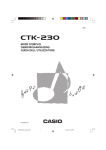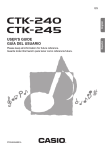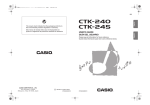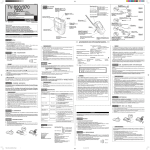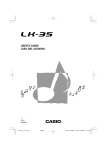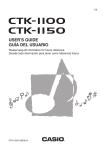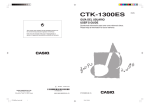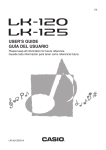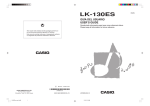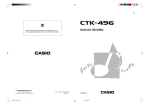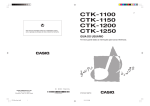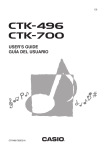Download Casio CTK720AD - 12-NOTE Polyphonic Electronic Keyboard User`s guide
Transcript
ES USER’S GUIDE GUÍA DEL USUARIO CTK230-ES-1 CTK230_ES_cover1.p65 1 03.10.7, 2:02 PM GUIDELINES LAID DOWN BY FCC RULES FOR USE OF THE UNIT IN THE U.S.A. (not applicable to other areas). NOTICE This equipment has been tested and found to comply with the limits for a Class B digital device, pursuant to Part 15 of the FCC Rules. These limits are designed to provide reasonable protection against harmful interference in a residential installation. This equipment generates, uses and can radiate radio frequency energy and, if not installed and used in accordance with the instructions, may cause harmful interference to radio communications. However, there is no guarantee that interference will not occur in a particular installation. If this equipment does cause harmful interference to radio or television reception, which can be determined by turning the equipment off and on, the user is encouraged to try to correct the interference by one or more of the following measures: • Reorient or relocate the receiving antenna. • Increase the separation between the equipment and receiver. • Connect the equipment into an outlet on a circuit different from that to which the receiver is connected. • Consult the dealer or an experienced radio/TV technician for help. FCC WARNING Changes or modifications not expressly approved by the party responsible for compliance could void the user’s authority to operate the equipment. Important! Please note the following important information before using this product. • Before using the optional AD-5 Adaptor to power the unit, be sure to check the AC Adaptor for any damage first. Carefully check the power cord for breakage, cuts, exposed wire and other serious damage. Never let children use an AC adaptor that is seriously damaged. • Never attempt to recharge batteries. • Do not use rechargeable batteries. • Never mix old batteries with new ones. • Use recommended batteries or equivalent types. • Always make sure that positive (+) and negative (–) poles are facing correctly as indicated near the battery compartment. • Replace batteries as soon as possible after any sign they are getting weak. • Do not short-circuit the battery terminals. • The product is not intended for children under 3 years. • Use only CASIO AD-5 adaptor. • The AC adaptor is not a toy. • Be sure to disconnect the AC adaptor before cleaning the product. CASIO ELECTRONICS CO., LTD. Unit 6, 1000 North Circular Road London NW2 7JD, U.K. This mark is valid in the EU countries only. Please keep all information for future reference. 277A-E-002A CTK230_E_CE.p65 8 03.10.7, 2:01 PM Safety Precautions Congratulations on your selection of the CASIO electronic musical instrument. • Before using the instrument, be sure to carefully read through the instructions contained in this manual. • Please keep all information for future reference. Symbols Various symbols are used in this user’s guide and on the product itself to ensure that the product is used safely and correctly, and to prevent injury to the user and other persons as well as damage to property. Those symbols along with their meanings are shown below. DANGER This symbol indicates information that, if ignored or applied incorrectly, creates the danger of death or serious personal injury. Symbol Examples This triangle symbol ( ) means that the user should be careful. (The example at left indicates electrical shock caution.) This circle with a line through it ( ) means that the indicated action must not be performed. Indications within or nearby this symbol are specifically prohibited. (The example at left indicates that disassembly is prohibited.) The black dot ( ) means that the indicated action must be performed. Indications within this symbol are actions that are specifically instructed to be performed. (The example at left indicates that the power plug must be unplugged from the electrical socket.) WARNING This indication stipulates matters that have the risk of causing death or serious injury if the product is operated incorrectly while ignoring this indication. CAUTION This indication stipulates matters that have the risk of causing injury as well as matters for which there is the likelihood of occurrence of physical damage only if the product is operated incorrectly while ignoring this indication. E-1 277A-E-003A CTK230_E01-07.p65 1 03.10.7, 2:01 PM Safety Precautions DANGER Alkaline Batteries Perform the following steps immediately if fluid leaking from alkaline batteries ever gets into your eyes. 1. Do not rub your eyes! Rinse them with water. 2. Contact your physician immediately. Leaving alkaline battery fluid in your eyes can lead to loss of sight. WARNING Smoke, Strange Odor, Overheating Continued use of the product while it is emitting smoke, a strange odor, or heat creates the risk of fire and electric shock. Take the following steps immediately. 1. Turn off power. 2. If you are using the AC adaptor for power, unplug it from the wall outlet. 3. Contact your original retailer or an authorized CASIO Service Provider. AC Adaptor Misuse of the AC adaptor creates the risk of fire and electric shock. Always make sure you observe the following precautions. • Be sure to use only the AC adaptor that is specified for this product. • Use only a power source whose voltage is within the rating marked on the AC adaptor. • Do not overload electrical outlets and extension cords. AC Adaptor Misuse of the AC adaptor’s electric cord can damage or break it, creating the risk of fire and electric shock. Always make sure you observe the following precautions. • Never place heavy objects on the cord or subject it to heat. • Never try to modify the cord or subject it to excessive bending. • Never twist or stretch the cord. • Should the electric cord or plug become damaged, contact your original retailer or authorized CASIO Service Provider. AC Adaptor Never touch the AC adaptor while your hands are wet. Doing so creates the risk of electric shock. Batteries Misuse of batteries can cause them to leak, resulting in damage to nearby objects, or to explode, creating the risk of fire and personal injury. Always make sure you observe the following precautions. • Never try to take batteries apart or allow them to become shorted. • Never expose batteries to heat or dispose of them by incineration. • Never mix old batteries with new ones. • Never mix batteries of different types. • Do not charge the batteries. • Make sure the positive (+) and negative (–) ends of the batteries are facing correctly. E-2 CTK230_E01-07.p65 277A-E-004A 2 03.10.7, 2:01 PM Safety Precautions Do not incinerate the product. Never throw the product into fire. Doing so can cause it to explode, creating the risk of fire and personal injury. Water and Foreign Matter Water, other liquids, and foreign matter (such as pieces of metal) getting into the product create the risk of fire and electric shock. Take the following steps immediately. 1. Turn off power. 2. If you are using the AC adaptor for power, unplug it from the wall outlet. 3. Contact your original retailer or an authorized CASIO Service Provider. Disassembly and Modification Never try to take this product apart or modify it in any way. Doing so creates the risk of electric shock, burn injury, or other personal injury. Leave all internal inspection, adjustment, and maintenance up to your original retailer or authorized CASIO Service Provider. Plastic Bags Never place the plastic bag the product comes in over your head or in your mouth. Doing so creates the risk of suffocation. Particular care concerning this precaution is required where small children are present. Keep off of the product and stand.* Climbing onto the product or stand can cause it to tip over or become damaged. Particular care concerning this precaution is required where small children are present. Location Avoid locating the product on an unstable stand, on an uneven surface, or any other unstable location. An unstable location can cause the product to fall over, creating the risk of personal injury. Dropping and Impact Continued use of this product after it has been damaged by dropping or subjecting it to strong impact creates the risk of fire and electric shock. Take the following steps immediately. 1. Turn off power. 2. If you are using the AC adaptor for power, unplug it from the wall outlet. 3. Contact your original retailer or an authorized CASIO Service Provider. E-3 277A-E-005A CTK230_E01-07.p65 3 03.10.7, 2:01 PM Safety Precautions CAUTION AC Adaptor Misuse of the AC adaptor creates the risk of fire and electric shock. Always make sure you observe the following precautions. • Do not locate the electric cord near a stove or other sources of heat. • Never pull on the cord when unplugging from the electrical outlet. Always grasp the AC adaptor when unplugging. AC Adaptor Misuse of the AC adaptor creates the risk of fire and electric shock. Always make sure you observe the following precautions. • Insert the AC adaptor into the wall outlet as far as it will go. • Unplug the AC adaptor from the wall outlet during lightening storms or before leaving on a trip or other longterm absence. • At least once a year, unplug the AC adaptor from the wall outlet and wipe away any dust that is built up in the area around the prongs of the plug. Relocating the Product Before relocating the product, always unplug the AC adaptor from the wall outlet and disconnect all other cables and connecting cords. Leaving cords connected creates the risk of damage to the cords, fire, and electric shock. Cleaning Before cleaning the product, always unplug the AC adaptor from the wall outlet first. Leaving the AC adaptor plugged in creates the risk of damage to the AC adaptor, fire, and electric shock. Batteries Misuse of batteries can cause them to leak resulting in damage to nearby objects, or to explode, creating the risk of fire and personal injury. Always make sure you observe the following precautions. • Use only batteries that are specified for use with this product. • Remove batteries from the product if you do not plan to use it for a long time. Connectors Connect only the specified devices and equipment to the product’s connectors. Connection of a non-specified device or equipment creates the risk of fire and electric shock. Location Avoid the following locations for this product. Such locations create the risk of fire and electric shock. • Areas subject to high humidity or large amounts of dust. • In food preparation areas or other areas subject to oil smoke. • Near air conditioning equipment, on a heated carpet, in areas exposed to direct sunlight, inside of a vehicle parked in the sun, or any other area that subjects the product to high temperatures. E-4 CTK230_E01-07.p65 277A-E-006A 4 03.10.7, 3:53 PM Safety Precautions Display Screen • Never push on the display screen’s LCD panel or subject it to strong impact. Doing so can cause the LCD panel’s glass to crack, creating the risk of personal injury. • Should the LCD panel ever crack or break, never touch the liquid inside of the panel. LCD panel liquid can cause skin irritation. • Should LCD panel liquid ever get inside your mouth, immediately wash out your mouth with water and contact your physician. • Should LCD panel liquid ever get into your eyes or onto your skin, rinse with clear water for at least 15 minutes, and then contact a physician. Sound Volume Do not listen to music at very loud volumes for long periods. Particular care concerning this precaution is required when using headphones. High volume settings can damage your hearing. Heavy Objects Never place heavy object on top of the product. Doing so can make the product top heavy, causing the product to tip over or the object to fall from it, creating the risk of personal injury. Correct Stand* Assembly An incorrectly assembled stand can tip over, causing the product to fall and creating the risk of personal injury. Make sure you assemble the stand correctly, following the assembly instructions that come with it. Make sure you mount the product on the stand correctly. * Stand is available as an option. IMPORTANT! When using batteries, be sure to replace them or shift to one of the alternate power sources whenever you notice any of the following symptoms. • Dim power indicator • Instrument does not turn on • Display that is flickering, dim, or difficult to read • Abnormally low speaker/headphone volume • Distortion of sound output • Occasional interruption of sound when playing at high volume • Sudden power failure when playing at high volume • Flickering or dimming of the display when playing at high volume • Continued sound output even after you release a key • A tone that is totally different from the one that is selected • Abnormal rhythm pattern and Song Bank play E-5 277A-E-007A CTK230_E01-07.p65 5 03.10.7, 2:01 PM Introduction Congratulations upon your selection of this CASIO musical instrument. This keyboard provides you with the following features and functions. ❐ 100 tones Choose from among orchestral sounds, synthesized sounds, and more. ❐ 100 rhythms 100 versatile rhythms help to add plenty of life to all your keyboard performances. ❐ Auto Accompaniment Simply play a chord and the corresponding rhythm, bass and chord parts play automatically. ❐ 50-tune Song Bank A wide selection of favorites including “ODE TO JOY” and “JINGLE BELLS” is yours for your listening enjoyment or play along fun. A simple operation cuts out the melody part of the tune, allowing you to play along on the keyboard. E-6 CTK230_E01-07.p65 277A-E-008A 6 03.10.7, 2:01 PM Contents Safety Precautions ........... E-1 Introduction ...................... E-6 Contents ............................ E-7 Adjusting the Accompaniment Volume .......................................... E-24 Using the Song Bank ..... E-25 Playing Back a Song Bank Tune .. E-25 Song Bank Mode Display ............. E-26 General Guide ................... E-8 Attachment of the Score Stand ...... E-9 Adjusting the Tempo of a Song Bank Tune ........................... E-27 Using the Display ......................... E-10 Changing the Tone of a Song Bank Tune’s Melody ........... E-27 Song Bank Quick Reference ............. E-11 Playing Along with a Song Bank Tune ........................... E-27 Playing Back a Song Bank Tune ... E-11 Power Supply ................. E-13 Applause Sound ........................... E-28 Playing Back All Song Bank Tunes in Succession .................... E-29 Using batteries ............................. E-13 Keyboard Settings ......... E-30 Using the AC Adaptor ................... E-14 Transposing the Keyboard ........... E-30 Auto Power Off ............................. E-15 Tuning the Keyboard .................... E-31 Settings ......................................... E-15 Connections ................... E-16 Phones/Output Terminal ............... E-16 Troubleshooting ............. E-32 Specifications ................. E-34 Accessories and Options ............. E-16 Care of your keyboard ... E-35 Basic Operations ............ E-17 Playing the Keyboard ................... E-17 Appendix ...........................A-1 Selecting a Tone ........................... E-17 Tone List ......................................... A-1 Rhythm List .................................... A-2 Auto Accompaniment .... E-19 Note Table ...................................... A-3 Selecting a Rhythm ...................... E-19 Fingered Chord Chart .................... A-5 Playing a Rhythm ......................... E-20 Percussion Instrument List ............. A-7 Adjusting the Tempo ..................... E-20 Using Auto Accompaniment ......... E-21 Using a Fill-in Pattern ................... E-23 Synchro Starting Accompaniment with Rhythm Play ......................... E-23 E-7 277A-E-009A CTK230_E01-07.p65 7 03.10.7, 2:01 PM General Guide 1 2 5 6 9 0 D 3 4 7 8 A B C 9 E F G K L H I J M E-8 CTK230_E08_18.p65 277A-E-010A 8 03.10.7, 2:01 PM General Guide 1 Power indicator D Chord name 2 POWER/MODE switch E Percussion instrument list 3 MAIN VOLUME buttons F SONG BANK button 4 TRANSPOSE/TUNE button G RHYTHM button 5 SYNCHRO/FILL-IN button H TONE button 6 START/STOP button I [+]/[–] buttons • Negative values can be changed only by using [+] and [–] to increase and decrease the displayed value. 7 TEMPO buttons 8 ACCOMP VOLUME button 9 Speaker J Number buttons • For input of numbers to change displayed settings. 0 Rhythm list A Tone list ● SONG BANK CONTROLLER B Song bank list K STOP button C Display L PLAY/PAUSE button M MELODY ON/OFF button Rear Panel N DC 9V jack O PHONES/OUTPUT terminal N O *Attachment of the Score Stand Insert both ends of the music stand provided with the keyboard into the two holes on the top surface. E-9 277A-E-011A CTK230_E08_18.p65 9 03.10.7, 2:01 PM General Guide Using the Display 2 3 1 4 Od e T o J o y 9 8 7 5 6 • This is how the display appears while the Song Bank is in use. 1. An indicator appears next to the type of setting you are currently performing (TONE, RHYTHM, SONG BANK). 2. 3. 4. 5. 6. 7. 8. 9. Tone number, rhythm number, song number, keyboard settings value Rhythm, auto-accompaniment, Song Bank tune beats Tone name, rhythm name, song name, mode name, keyboard setting names Auto-accompaniment and Song Bank chord names “MELODY” indicates the on/off status of the melody part during Song Bank playback. Rhythm, auto-accompaniment, Song Bank tune tempo Rhythm, auto-accompaniment, Song Bank tune tempo; volume setting Song Bank controller indicators NOTE • Display examples shown in this User’s Guide are intended for illustrative purposes only. The actual text and values that appear on the display may differ from the examples shown in this User’s Guide. E-10 CTK230_E08_18.p65 277A-E-012A 10 03.10.7, 2:01 PM Song Bank Quick Reference POWER/MODE MAIN VOLUME SONG BANK PLAY/PAUSE A selection of 50 Song Bank tunes comes built-in for your listening pleasure or play along fun. A simple operation cuts out the melody part of the tune, allowing you to play along on the keyboard. See “Using the Song Bank” on page E-25 for details on playing along with Song Bank tunes. 4 1 2 Set the POWER/MODE switch to NORMAL. Use the MAIN VOLUME buttons to lower the keyboard volume to a relatively low level. Use the Song Bank list to find the tune you want to play back, and then use the number buttons to input the tune’s two-digit number. Example: To select “40 ODE TO JOY”, input 4 and then 0. Od e T o J o y Playing Back a Song Bank Tune To play back a Song Bank tune Number buttons 5 Press the PLAY/PAUSE button to start play of the tune. • The tune plays in an endless loop, restarting after it reaches the end. Od e T o J o y Chord name 3 Press the SONG BANK button to enter the Song Bank Mode. Appears when SONG BANK button is pressed E-11 277A-E-013A CTK230_E08_18.p65 11 03.10.7, 2:01 PM Song Bank Quick Reference PLAY/PAUSE STOP 6 TONE MELODY ON/OFF Press the MELODY ON/OFF button to turn off the melody part and try playing along on the keyboard. Od e T o J o y 7 8 9 Press the MELODY ON/OFF button again to turn the melody part back on. Press the STOP button to stop playback of the Song Bank tune. Press the TONE button to exit the Song Bank Mode and return to the tone and rhythm selection screen. P i ano 1 Indicator turns off NOTE • You can also perform the following operation during play of a Song Bank tune. • Pause: Press the PLAY/PAUSE button. E-12 CTK230_E08_18.p65 277A-E-014A 12 03.10.7, 2:01 PM Power Supply This keyboard can be powered by current from a standard household wall outlet (using the specified AC adaptor) or by batteries. Always make sure you turn the keyboard off whenever you are not using it. Using batteries Always make sure you turn off the keyboard before loading or replacing batteries. To load batteries 1 Remove the battery compartment cover by sliding it in the direction of the arrow indicated in the figure. 2 Load 6 AA-size batteries into the battery compartment. • Make sure that the positive (+) and negative (–) ends are facing correctly. – + + – – + + – Important Battery Information ■ The following shows the approximate battery life. Alkaline batteries ............................... 6 hours* Manganese batteries .......................... 3 hours* * The above value is standard battery life at normal temperature, with the keyboard volume at medium setting. Temperature extremes or playing at very loud volume settings can shorten battery life. ■ Any of the following symptoms indicate low battery power. Replace batteries as soon as possible whenever any of the following occurs. • Dim power indicator • Instrument does not turn on • Display that is flickering, dim, or difficult to read • Abnormally low speaker/headphone volume • Distortion of sound output • Occasional interruption of sound when playing at high volume • Sudden power failure when playing at high volume • Flickering or dimming of the display when playing at high volume • Continued sound output even after you release a key • A tone that is totally different from the one that is selected • Abnormal rhythm pattern and Song Bank play – + + – WARNING 3 Replace the battery compartment cover by sliding it. – + + – – + + – – + + – The keyboard may not function correctly if you load or replace batteries with power turned on. If this happens, turning the keyboard off and then back on again should return functions back to normal. Misuse of batteries can cause them to leak, resulting in damage to nearby objects, or to explode, creating the risk of fire and personal injury. Always make sure you observe the following precautions. • Never try to take batteries apart or allow them to become shorted • Never expose batteries to heat or dispose of them by incineration. • Never mix old batteries with new ones. • Never mix batteries of different types. • Do not charge the batteries. • Make sure the positive (+) and negative (–) ends of the batteries are facing correctly. E-13 277A-E-015A CTK230_E08_18.p65 13 03.10.7, 2:01 PM Power Supply CAUTION CAUTION Misuse of batteries can cause them to leak resulting in damage to nearby objects, or to explode, creating the risk of fire and personal injury. Always make sure you observe the following precautions. • Use only batteries that are specified for use with this product. • Remove batteries from the product if you do not plan to use it for a long time. Using the AC Adaptor Make sure that you use only the AC adaptor specified for this keyboard. Specified AC Adaptor: AD-5 [Rear Panel] DC 9V jack Misuse of the AC adaptor creates the risk of fire and electric shock. Always make sure you observe the following precautions. • Do not locate the electric cord near a stove or other sources of heat. • Never pull on the cord when unplugging from the electrical outlet. Always grasp the AC adaptor when unplugging. • Insert the AC adaptor into the wall outlet as far as it will go. • Unplug the AC adaptor from the wall outlet during lightening storms or before leaving on a trip or other long-term absence. • At least once a year, unplug the AC adaptor from the wall outlet and wipe away any dust that is built up in the area around the prongs of the plug. IMPORTANT! AC adaptor AD-5 AC outlet • Make sure that the keyboard is turned off before connecting or disconnecting the AC adaptor. • Using the AC adaptor for a long time can cause it to become warm to touch. This is normal and does not indicate malfunction Also note the following important warnings and precautions when using the AC adaptor. WARNING Misuse of the AC adaptor creates the risk of fire and electric shock. Always make sure you observe the following precautions. • Be sure to use only the AC adaptor that is specified for this product. • Use only a power source whose voltage is within the rating marked on the AC adaptor. • Do not overload electrical outlets and extension cords. • Never place heavy objects on the cord or subject it to heat. • Never try to modify the cord or subject it to excessive bending. • Never twist or stretch the cord. • Should the electric cord or plug become damaged, contact your original retailer or authorized CASIO Service Provider. • Never touch the AC adaptor while your hands are wet. Doing so creates the risk of electric shock. E-14 CTK230_E08_18.p65 277A-E-016A 14 03.10.7, 2:01 PM Power Supply Auto Power Off When you are using battery power, keyboard power turns off automatically whenever you leave it on without performing any operation for about 6 minutes. When this happens, use the POWER/ MODE switch to turn power back on. NOTE • Auto Power Off is disabled (it does not function) when you are using the AC adaptor to power the keyboard. To disable Auto Power Off Hold down the TONE button while turning on the keyboard to disable Auto Power Off. NOTE • When Auto Power Off is disabled, the keyboard does not turn off automatically no matter how long it is left with no operation being performed. • Auto Power Off is automatically enabled whenever you turn on keyboard power. Settings All keyboard settings are returned to their initial defaults whenever keyboard power is turned back on after being turned off by operation of the POWER/MODE switch or Auto Power Off. E-15 277A-E-017A CTK230_E08_18.p65 15 03.10.7, 2:01 PM Connections Phones/Output Terminal Before connecting phones or other external equipment, be sure to first turn down the volume settings of the keyboard and the connected equipment. You can then adjust volume to the desired level after connections are complete. [Rear Panel] PHONES/OUTPUT Terminal Audio connection Musical Instrument Amplifier (Figure 3) Use a commercially available connecting cord* to connect the keyboard to a musical instrument amplifier. * Be sure to use a connecting cord that has standard plugs on the ends you connect to the keyboard and amplifier. When connected to a musical instrument amplifier, set the volume of the keyboard to a relatively low level and make output volume adjustments using the amplifier’s controls. 1 [Connection Example] Stereo standard plug 3 Keyboard amp, guitar amp,etc. White 2 Red PIN plug LEFT RIGHT To keyboard’s PHONES/OUTPUT jack INPUT Standard plug AUX IN or similar terminalof audio amplifier Connecting Phones (Figure 1) Connecting phones cuts off output from the keyboard’s built-in speakers, so you can play even late at night without disturbing anyone. Audio Equipment (Figure 2) Connect the keyboard to an audio equipment using a commercially available connecting cord with a standard plug on one end and two PIN plugs on the other end. In this configuration, you normally set the input selector of the audio equipment to the terminal (usually marked AUX IN or something similar) where the cord from the keyboard is connected. See the user documentation that comes with your audio equipment for full details. Accessories and Options Use only the accessories and options specified for this keyboard. Use of non-authorized items creates the danger of fire, electrical shock, and personal injury. E-16 CTK230_E08_18.p65 Keyboard or guitar amp 277A-E-018A 16 03.10.7, 2:01 PM Basic Operations POWER/MODE MAIN VOLUME TONE [+]/[-] This section provides information on performing basic keyboard operations. 2 Number buttons Press the TONE button. Appears when TONE button is pressed Playing the Keyboard P i ano 1 To play the keyboard 1 2 Set the POWER/MODE switch to NORMAL. Use the MAIN VOLUME buttons to lower the keyboard volume. • It’s always a good idea to set the keyboard volume at a relatively low level before playing. • Pressing [] or [] causes the current volume setting to appear on the display. Press [] or [] again to change the setting. 3 Use the number buttons to input the two digit tone number for the tone you want to select. Example: To select “26 WOOD BASS”, input 2 and then 6 . Wo o dBa s s Play something on the keyboard. Selecting a Tone This keyboard comes with 100 built-in tones. Use the following procedure to select the tone you want to use. To select a tone 1 3 Find the tone you want to use in the tone list and note its tone number. • Not all of the available tones are shown on the tone list printed on the keyboard console. For a complete list, see the “Tone List” on page A-1. • Now notes played on the keyboard will be played using an acoustical wood bass sound. NOTE • Always input both digits for the tone number, including a leading zero (if any). If you input one digit and stop, the display will automatically clear your input after a few seconds. • You can also increment the displayed tone number by pressing [+] and decrement it by pressing [–]. • Sound effect tones such as 77 VEHICLE sound best when you keep a keyboard key depressed. E-17 277A-E-019A CTK230_E08_18.p65 17 03.10.7, 2:01 PM Basic Operations Polyphony Combination tones The following describes the two types of combination tones that are available. Layered Tones (Tone Numbers: 80 through 89) Example: 80 STR PIANO This tone layers a strings tone with a piano tone so they both sound when a keyboard key is pressed. Split Tones (Tone Numbers: 90 through 96) Example: 90 BASS/PIANO This tone splits the keyboard so one range is assigned a bass tone and another range is assigned a piano tone. BASS The term polyphony refers to the maximum number of notes you can play at the same time. The keyboard has 12-note polyphony, which includes the notes you play as well as the rhythms and auto-accompaniment patterns that are played by the keyboard. This means that when a rhythm or auto-accompaniment pattern is being played by the keyboard, the number of notes (polyphony) available for keyboard play is reduced. Also note that some of the tones offer only 6-note polyphony. NOTE • When rhythm or auto accompaniment is playing, the number of sounds simultaneously played is reduced. PIANO Digital Sampling Percussion sounds Example: 99 PERCUSSION This tone assigns various percussion sounds to the keyboard. See the “Percussion Instrument List” on page A-7 for full details. Sound Effect Tones With sound effect tones 77 through 79, the type of sound produced depends on the octave where the key you press is located. When 78 PHONE is selected available sound types are PUSH TONE 1, PUSH TONE 2, RING 1, and RING 2. A number of the tones that are available with this keyboard have been recorded and processed using a technique called digital sampling. To ensure a high level of tonal quality, samples are taken in the low, mid, and high ranges and then combined to provide you with sounds that are amazingly close to the originals. You may notice very slight differences in volume or sound quality for some tones when you play them at different positions on the keyboard. This is an unavoidable result of multiple sampling, and it is not a sign of malfunction. E-18 CTK230_E08_18.p65 277A-E-020A 18 03.10.7, 2:02 PM Auto Accompaniment RHYTHM [+]/[-] This keyboard automatically plays bass and chord parts in accordance with the chords you finger. The bass and chord parts are played using sounds and tones that are automatically selected to select the rhythm you are using. All of this means that you get full, realistic accompaniments for the melody notes you play with your right hand, creating the mood of a one-person ensemble. 2 Number buttons Press the RHYTHM button. Appears when RHYTHM button is pressed C l ub Pop 3 Use the number buttons to input the two digit rhythm number for the rhythm you want to select. Example: To select “64 WALTZ”, input 6 and then 4. Wa l t z Selecting a Rhythm This keyboard provides you with 100 exciting rhythms that you can select using the following procedure. NOTE To select a rhythm 1 Find the rhythm you want to use in the rhythm list and note its rhythm number. • Not all of the available rhythms are shown on the rhythm list printed on the keyboard console. For a complete list, see the “Rhythm List” on page A-2. • “00 CLUB POP” is the initial default rhythm setting whenever you turn on keyboard power. • You can also increment the displayed rhythm number by pressing [+] and decrement it by pressing [–]. E-19 277A-E-021A CTK230_E19_24.p65 19 03.10.7, 2:02 PM Auto Accompaniment POWER/MODE TEMPO START/STOP Playing a Rhythm To adjust the tempo Use the following procedure to start and stop rhythm play. To play a rhythm 1 2 3 Set the POWER/MODE switch to NORMAL. 1 Use the TEMPO buttons ( / ) to adjust the tempo. : Increases the tempo value. : Decreases the tempo value. Example: Hold down the button until the tempo value 110 is on the display. Press the START/STOP button to start play of the currently selected rhythm. To stop rhythm play, press the START/STOP button again. NOTE NOTE • Pressing both TEMPO buttons ( and ) at the same time resets the tempo to the default value of the currently selected rhythm. • All of the keyboard keys are melody keys while the POWER/MODE switch is set to NORMAL. About the Graphic Metronome Adjusting the Tempo You can adjust the tempo of rhythm play within a range of 20 to 255 beats per minute. The tempo setting is applied to Auto Accompaniment chord play, and song bank operations. The graphic metronome appears on the display along with the tempo value and beat of a rhythm or built-in tune. The graphic metronome helps you keep in time as you play along with a rhythm or built-in tune. Beat Tempo value E-20 CTK230_E19_24.p65 Graphic metronome 277A-E-022A 20 03.10.7, 2:02 PM Auto Accompaniment Using Auto Accompaniment The following procedure describes how to use the keyboard’s Auto Accompaniment feature. Before starting, you should first select the rhythm you want to use and set the tempo of the rhythm to the value you want. CASIO CHORD Accompaniment Keyboard and Melody Keyboard Accompaniment keyboard Melody keyboard To use Auto Accompaniment 1 2 3 NOTE Set the POWER/MODE switch to CASIO CHORD or FINGERED. Press the START/STOP button to start play of the currently selected rhythm. Play a chord. • The actual procedure you should use to play a chord depends on the current POWER/MODE switch position. Refer to the following pages for details on chord play. CASIO CHORD ........................... This page FINGERED .................................. Page E-22 C l ub Pop Chord name 4 To stop Auto Accompaniment play, press the START/STOP button again. CASIO CHORD This method of chord play makes it possible for anyone to easily play chords, regardless of previous musical knowledge and experience. The following describes the CASIO CHORD “Accompaniment keyboard” and “Melody keyboard”, and tells you how to play CASIO CHORDs. • The accompaniment keyboard can be used for playing chords only. No sound will be produced if you try playing single melody notes on the accompaniment keyboard. Chord Types CASIO CHORD accompaniment lets you play four types of chords with minimal fingering. Chord Types Major chords Major chord names are marked above the keys of the accompaniment keyboard. Note that the chord produced when you press an accompaniment keyboard does not change octave, regardless of which key you use to play it. Minor chords (m) To play a minor chord, keep the major chord key depressed and press any other accompaniment keyboard key located to the right of the major chord key. Seventh chords (7) To play a seventh chord, keep the major chord key depressed and press any other two accompaniment keyboard keys located to the right of the major chord key. Minor seventh chords (m7) To play a minor seventh chord, keep the major chord key depressed and press any other three accompaniment keyboard keys located to the right of the major chord key. C Major (C) CC#DE E FF#GA A B B CC# DE E F C minor (Cm) CC#DE E FF#GA A B B CC# DE E F C seventh (C7) CC#DE E FF#GA A B B CC# DE E F C minor seventh (Cm7) CC#DE E FF#GA A B B CC# DE E F E-21 277A-E-023A CTK230_E19_24.p65 Example 21 03.10.7, 2:02 PM Auto Accompaniment NOTE • It makes no difference whether you press black or white keys to the right of a major chord key when playing minor and seventh chords. C Cm Cdim Caug *1 Csus4 C7 *2 Cm7 *2 Cmaj7 *2 Cm75 C7 5 *1 C7sus4 Cadd9 *2 Cmadd9 *2 CmM7 *2 Cdim7 *1 FINGERED FINGERED provides you with a total of 15 different chord types. The following describes the FINGERED “Accompaniment keyboard” and “Melody keyboard”, and tells you how to play a C-root chord using FINGERED. FINGERED Accompaniment Keyboard and Melody Keyboard Accompaniment keyboard Melody keyboard NOTE • The accompaniment keyboard can be used for playing chords only. No sound will be produced if you try playing single melody notes on the accompaniment keyboard. See the “Fingered Chord Chart” on page A-5 for details on playing chords with other roots. *1: Inverted fingerings cannot be used. The lowest note is the root. *2: The same chord can be played without pressing the 5th G. NOTE • Except for the chords specified in note *1 above, inverted fingerings (i.e. playing E-GC or G-C-E instead of C-E-G) will produce the same chords as the standard fingering. • Except for the exception specified in note*2 above, all of the keys that make up a chord must be pressed. Failure to press even a single key will not play the desired FINGERED chord. E-22 CTK230_E19_24.p65 277A-E-024A 22 03.10.7, 2:02 PM Auto Accompaniment POWER/MODE START/STOP SYNCHRO/FILL-IN Using a Fill-in Pattern Fill-in patterns let you momentarily change the rhythm pattern to add some interesting variation to your performances. To use synchro start 1 Press the SYNCHRO/FILL-IN button to put the keyboard into synchro start standby. The following procedure describes how to use the Fill-in feature. Flash To insert a fill-in 1 2 Press the START/STOP button to start rhythm play. Press the SYNCHRO/FILL-IN button to insert a fill-in pattern for the rhythm you are using. Synchro Starting Accompaniment with Rhythm Play 2 Play a chord on the accompaniment keyboard and the rhythm pattern starts to play automatically. NOTE • If the POWER/MODE switch is set to NORMAL, only the rhythm plays (without a chord) when you play on the accompaniment keyboard. • To cancel synchro start standby, press the SYNCHRO/FILL-IN button one more time. You can set up the keyboard to start rhythm play at the same time you play the accompaniment on the keyboard. The following procedure describes how to use synchro start. Before starting, you should first select the rhythm you want to use, set the tempo, and use the POWER/MODE switch to select the chord play method you want to use (CASIO CHORD, FINGERED). E-23 277A-E-025A CTK230_E19_24.p65 23 03.10.7, 2:02 PM Auto Accompaniment ACCOMP VOLUME [+]/[-] Number buttons Adjusting the Accompaniment Volume You can adjust the volume of the accompaniment parts as a value in the range of 0 (minimum) to 9. 1 Press the ACCOMP VOLUME button. Current accompaniment volume setting A c cmp V o l 2 Use the number buttons or the [+]/[–] buttons to change the current volume setting value. Example: 5 A c cmp V o l NOTE • The current accompaniment volume value that appears in Step 1 automatically clears from the display if you do not input anything within about five seconds. • Pressing [+] and [–] buttons at the same time automatically sets an accompaniment volume of 7. E-24 CTK230_E19_24.p65 277A-E-026A 24 03.10.7, 2:02 PM Using the Song Bank POWER/MODE SONG BANK [+]/[-] A selection of 50 Song Bank tunes comes built-in for your listening enjoyment or play along fun. You can turn off the melody part to practice with the remaining part. 4 Use the Song Bank list to find the tune you want to play back, and then use the number buttons to input the tune’s two-digit number. Example: To select “31 ALOHA OE”, input 3 and then 1. Playing Back a Song Bank Tune Song Number 2 3 Set the POWER/MODE switch to NORMAL, FINGERED, or CASIO CHORD. Adjust the main volume and accomp volume. Press the SONG BANK button to enter the Song Bank Mode. Song Name A l o h a Oe To play back a Song Bank tune 1 Number buttons NOTE • “00 TWINKLE TWINKLE LITTLE STAR” is the initial default Song Bank tune setting whenever you turn on keyboard power. • You can also increment the displayed tune number by pressing [+] and decrement is by pressing [–]. Appears when SONG BANK button is pressed E-25 277A-E-027A CTK230_E25_29.p65 25 03.10.7, 2:02 PM Using the Song Bank TEMPO MELODY ON/OFF STOP 5 Press the PLAY/PAUSE button to start play of the tune. Appears when PLAY/PAUSE button is pressed A l o h a Oe Chord name 6 PLAY/PAUSE [+]/[-] Number buttons NOTE • Each time you select a new Song Bank tune, the tone, tempo, and rhythm that is programmed for the tune are automatically selected. You can change a tune’s tone and tempo during playback, but you cannot change the rhythm. • You can also adjust the accompaniment volume (page E-24) for Song Bank tunes. Song Bank Mode Display In the Song Bank Mode, the display shows a variety of information about the tune being played. Press the STOP button to stop playback of the Song Bank tune. To pause Song Bank tune play 1 TONE [Playback Display] Notes played A l o h a Oe While a Song Bank tune is playing, press the PLAY/PAUSE button to pause it. The indicator “ll” appears while a tune play is paused. Tune tempo 2 Chord name To resume play, press PLAY/PAUSE again. E-26 CTK230_E25_29.p65 277A-E-028A 26 03.10.7, 2:02 PM Using the Song Bank Adjusting the Tempo of a Song Bank Tune To change the tempo of a Song Bank tune The tempo can be set within a range of 20 to 255 beats per minute. The tempo setting can be adjusted while the tune is stopped, playing back, or paused. 1 Use the TEMPO buttons [ / ] to adjust the tempo. : each press increases the value : each press decreases the value NOTE • Pressing both the [+] and [–] buttons at the same time selects “00 PIANO 1”. • To return a Song Bank tune to its original settings, simply select that tune again. Playing Along with a Song Bank Tune Each Song Bank tune has an accompaniment part and a melody part. You can turn off the melody part of a Song Bank tune and play along with the remaining part on the keyboard. To play along with a Song Bank tune NOTE • Pressing both the [] and [] TEMPO buttons at the same time returns the tempo setting to the preset value for the currently selected tune. 1 2 Changing the Tone of a Song Bank Tune’s Melody You can select any one of the keyboard’s 100 tones to be used to play the melody part of a Song Bank tune. The tone setting can be changed while the tune is stopped or playing back. 1 Press the MELODY ON/OFF button to turn off the melody part. • The on/off status of the melody part is indicated by “MELODY” that appears on the display. The melody part is turned on when “MELODY” is displayed, and turned off when “MELODY” is not displayed. While a song is playing back, press the TONE button. Gu t G t r 2 Perform steps 1 through 4 under “To play back a Song Bank tune” on page E-25 to select the song you want to play along with. Indicator turns off. Find the tone you want in the Tone List, and then use the number buttons or the [+] and [–] buttons to specify the tone number. Example: To select “30 VIOLIN”, input 3 and then 0. Viol in E-27 277A-E-029A CTK230_E25_29.p65 27 03.10.7, 2:02 PM Using the Song Bank PLAY/PAUSE RHYTHM STOP 3 TONE MELODY ON/OFF Press the PLAY/PAUSE button to start play of the Song Bank Tune. Applause Sound • Only the accompaniment part is played, so you can play the melody part on the keyboard. Whenever you turn off the melody part of a Song Bank tune and play it back, an applause sound is produced when the tune reaches the end. A l o h a Oe To turn off the applause sound 1 Press the STOP button and the MELODY ON/OFF button at the same time. A p l s =O f f 4 To end playback, press the STOP button. NOTE • The selected Song Bank tune continues to repeat until you stop playback by pressing the STOP button. • Pressing the STOP button and the MELODY ON/OFF button at the same time again turns the applause sound back on. E-28 CTK230_E25_29.p65 277A-E-030A 28 03.10.7, 2:02 PM Using the Song Bank Playing Back All Song Bank Tunes in Succession 1 Use the TONE or RHYTHM button to change to any mode other than the Song Bank Mode. • Make sure a dot is not on the display next to the SONG BANK indicator. Indicator turns off. Gu t G t r 2 3 Press the PLAY/PAUSE button to start playback of the Song Bank tunes starting from tune 00. To stop Song Bank tune playback, press the STOP button. • Pausing playback automatically cancels consecutive playback of all Song Bank tunes. Re-starting playback causes repeat playback of the current tune only. E-29 277A-E-031A CTK230_E25_29.p65 29 03.10.7, 2:02 PM Keyboard Settings TRANSPOSE/TUNE [+]/[-] Transposing the Keyboard Transpose lets you raise and lower the overall key of the keyboard in semitone units. If you want to play an accompaniment for a vocalist who sings in a key that’s different from the keyboard, for example, simply use transpose to change the key of the keyboard. To transpose the keyboard 1 Press the TRANSPOSE/TUNE button until the transpose screen appears on the display. NOTE • The keyboard can be transposed within a range of –6 to +5. • The default transpose setting is “0” when keyboard power is turned on. • If you leave the transpose screen on the display for about five seconds without doing anything, the screen is automatically cleared. • The transpose setting also affects Auto Accompaniment. • Playing back a Song Bank tune automatically returns the transpose setting to its standard default of “0”. Tr ans 2 Use [+] and [–] to change the transpose setting of the keyboard. Example: To transpose the keyboard five semitones upwards. Tr ans ( + ) E-30 CTK230_E30_31.p65 277A-E-032A 30 03.10.7, 2:02 PM Keyboard Settings Tuning the Keyboard The tuning feature lets you fine tune the keyboard to match the tuning of another musical instrument. To tune the keyboard 1 Press the TRANSPOSE/TUNE button twice to display the tuning screen. Tune 2 Use [+] and [–] to change the tuning setting of the keyboard. Example: To lower the tuning by 20. Tune (-) NOTE • The keyboard can be tuned within a range of –50 cents to +50 cents. *100 cents is equivalent to one semitone. • The default tuning setting is “00” when keyboard power is turned on. • If you leave the tuning screen on the display for about five seconds without doing anything, the screen is automatically cleared. • The tuning setting also affects Auto Accompaniment. • Playing back a Song Bank tune automatically returns the tuning setting to its standard default of “00”. E-31 277A-E-033A CTK230_E30_31.p65 31 03.10.7, 2:02 PM Troubleshooting Problem No keyboard Sound Possible Cause 1. Power supply problem. 2. Power is not turned on. 3. Volume setting is too low. 4. The POWER/MODE switch is in the CASIO CHORD or FINGERED position. Action See 1. Correctly attach the AC adaptor, make sure that batteries poles (+/–) are facing correctly, and check to make sure that batteries are not dead. 2. Set the POWER/MODE switch to the NORMAL position. 3. Use the MAIN VOLUME buttons to increase volume. 4. Normal play is not possible on the accompaniment keyboard while the POWER/MODE switch is set to CASIO CHORD or FINGERED. Change the POWER/MODE switch setting to NORMAL. Pages E-13, 14 Page E-17 Page E-17 Page E-17 Any of the following symptoms while using battery power. • Dim power indicator • Instrument does not turn on • Display that is flickering, dim, or difficult to read • Abnormally low speaker/ headphone volume • Distortion of sound output • Occasional interruption of sound when playing at high volume • Sudden power failure when playing at high volume • Flickering or dimming of the display when playing at high volume • Continued sound output even after you release a key • A tone that is totally different from the one that is selected • Abnormal rhythm pattern and Song Bank play Low battery power Replace the batteries with a set of new ones or use the AC adaptor. Pages E-13, 14 Auto Accompaniment does not sound. Auto accompaniment volume is set to 0. Use the ACCOMP VOLUME button to increase the volume. Page E-24 E-32 CTK230_E32-35.p65 277A-E-034A 32 03.10.7, 2:02 PM Troubleshooting Problem Possible Cause Action The key or tuning does not match when playing along with another instrument. The tuning or transpose parameter is set to a value other than 0 or 00. Change the transpose or tuning parameter value to 0 or 00. Pages E-30, 31 Missing Song Bank tune Melody part is turned off. Press the MELODY ON/OFF button to turn on the melody part. Page E-27 E-33 277A-E-035A CTK230_E32-35.p65 See 33 03.10.7, 2:02 PM Specifications Model: CTK-230 Keyboard: 49 standard-size keys, 4 octaves Tones: 100 Polyphony: 12 notes maximum (6 for certain tones) Auto Accompaniment Rhythm Patterns: Tempo: Chords: Rhythm Controller: Accomp Volume: 100 Variable (236 steps, = 20 to 255) 2 fingering methods (CASIO CHORD, FINGERED) START/STOP, SYNCHRO/FILL-IN 0 to 9 (10 steps) Song Bank Tunes: Controllers: 50 PLAY/PAUSE, STOP, MELODY ON/OFF Display Name display: TONE, RHYTHM, SONG BANK name/number, keyboard setting names/values Tempo value, metronome, synchro standby, beat indicator, volume setting Chord name PLAY, PAUSE, MELODY ON/OFF Tempo: Chord: Song Bank Status: Other Functions Transpose: Tuning: Volume: 12 steps (–6 semitones to +5 semitones) Variable (A4 = approximately 440Hz ±50 cents) 0 to 9 (10 steps) Terminals Phones/Output Terminal: Stereo standard jack (Output is monaural.) Output Impedance: 78Ω Output Voltage: 3V (RMS) MAX 9V DC Power Supply Terminal: Dual power supply system 6 AA-size batteries Approximately 6 hours continuous operation on alkaline batteries Approximately 3 hours continuous operation on manganese batteries AD-5 Turns power off approximately 6 minutes after last operation. Enabled under battery power only, can be disabled manually. Power Supply: Batteries: Battery Life: AC Adaptor: Auto Power Off: Speaker Output: ø 10cm 2 (1.6W + 1.6W) Power Consumption: 9V Dimensions: 87.5 30.0 10.0 cm (34 1/2 11 13/16 3 15/16 inch) Weight: Approximately 3.2 kg (7.1 lbs) (without batteries) 6.5W E-34 CTK230_E32-35.p65 277A-E-036A 34 03.10.7, 2:02 PM Care of your keyboard Avoid heat, humidity or direct sunlight. Do not overexpose the instrument to direct sunlight, or place it near an air conditioner, or in any extremely hot place. Do not use near a TV or radio. This instrument can cause video or audio interference with TV and radio reception. If this happens, move the instrument away from the TV or radio. Do not use lacquer, thinner or similar chemicals for cleaning. Clean the keyboard with a soft cloth dampened in a weak solution of water and a neutral detergent. Soak the cloth in the solution and squeeze until it is almost dry. Avoid use in areas subjected to temperature extremes. Extreme heat can cause figures on the LCD screen to become dim and difficult to read. This condition should correct itself when the keyboard is brought back to normal temperature. NOTE • You may notice lines in the finish of the case of this keyboard. These lines are a result of the molding process used to shape the plastic of the case. They are not cracks or breaks in the plastic, and are no cause for concern. E-35 277A-E-037A CTK230_E32-35.p65 35 03.10.7, 2:02 PM Appendix/Apéndice Tone List/Lista de sonidos PIANO 34 STRINGS2 SYNTH-SOUNDII 00 PIANO1 35 STRINGS3 70 01 PIANO2 36 SYNTH-STR1 HONKY-TONK SYNTH-STR2 COSMIC SOUND 02 37 71 STUDIOPIANO CHOIR SOUNDTRACK 03 38 72 04 ELEC PIANO1 39 VOICE OOH 05 ELEC PIANO2 BRASS 75 APPLAUSE 06 ELEC PIANO3 40 TRUMPET 76 SYNTH-SFX 07 ELEC PIANO4 41 TUBA 77 VEHICLE 08 HARPSICHORD 42 BRASS ENS 78 PHONE 09 CLAVELECTRO 43 FR.HORN1 79 FUNNY ORGAN 44 FR.HORN2 LAYER 10 ELEC ORGAN1 45 BRASS1 BRASS2 STR PIANO ELEC ORGAN2 46 80 11 81 STR E.PIANO 12 ELEC ORGAN3 47 SYN-BRASS1 82 CHOIRE.P 13 ELEC ORGAN4 48 SYN-BRASS2 CHURCH ORGAN SYN-BRASS3 CHOIR ORGAN 14 49 83 15 PIPE ORGAN 16 17 18 19 PEARL DROP 73 SPACE PAD 74 VOICE BASS 84 STR GUITAR REED/PIPE 85 STR HARP REED ORGAN 50 SOPRANO SAX 86 BRASS STR ACCORDION 51 ALTO SAX 87 VIB PAD BANDONEON 52 TENOR SAX 88 12 STR GTR HARMONICA 53 OBOE 89 CHOIR STR GUITAR/BASS 54 CLARINET SPLIT/PERCUSSION 20 GUT GUITAR 55 PICCOLO FLUTE BASS/PIANO ACOUS GUITAR 56 90 21 JAZZ GUITAR RECORDER BASS/E.PIANO 22 57 91 23 ELEC GUITAR 58 PAN FLUTE 24 MUTE GUITAR 59 WHISTLE 94 V.BASS/OOH 25 DIST GUITAR SYNTH-SOUNDI 95 STR/PIANO 26 WOOD BASS 60 SYN-LEAD1 96 STR/TRUMPET 27 ELEC BASS 61 SYN-LEAD2 97 VIBRAPHONE 28 SLAP BASS 62 SYN-LEAD3 98 MARIMBA 29 BANJO 63 SYN-CALLIOPE 99 PERCUSSION STRINGS/ENSEMBLE 64 SYN-PAD1 30 VIOLIN 65 SYN-PAD2 CELLO 66 SYN-PAD3 32 HARP 67 GLASS HMCA 33 STRINGS1 68 COUNTRY FARM 69 SYN-BASS 31 92 BASS/VIB 93 BASS/GUT GTR A-1 277A-E-075A CTK230_ES_APPENDIX.p65 1 03.10.7, 2:02 PM Appendix/Apéndice Rhythm List/Lista de ritmos POPS I 34 STRAIGHT ROCK LATIN I 00 CLUB POP 35 HEAVY METAL 70 BOSSA NOVA 01 VOCAL POP 36 TWIST RAP POP NEW ORLNS R&R SAMBA 02 37 71 03 FUNKY POP 1 38 CHICAGO BLUES 04 SOUL BALLAD 39 R&B 74 CHA-CHA-CHA 05 POP BALLAD JAZZ/FUSION 75 MERENGUE 06 LOVE BALLAD 40 BIG BAND 76 REGGAE 07 FUNKY POP 2 41 SLOW SWING 77 BOLERO 08 EPIC BALLAD 42 SWING 78 TANGO 2 09 LITE POP 43 FOX TROT 79 LAMBADA 72 MAMBO 73 RHUMBA POPS II 44 JAZZ WALTZ LATIN II/VARIOUS I 10 16 BEAT SHUFFLE 45 MODERN JAZZ COOL PUNTA 16 BEAT POP 46 80 11 81 CUMBIA 12 16 BEAT FUNK 47 HARD BOP 82 SKA 13 8 BEAT POP 48 ACID JAZZ 8 BEAT SOUL LATIN FUSION TEX-MEX 14 49 83 84 SALSA 15 8 BEAT SHUFFLE DANCE/FUNK 85 FOLKLORE 16 DANCE POP 1 50 VOCAL GROOVE 86 PASODOBLE 17 DANCE POP 2 51 RAVE 87 RUMBA CATALANA 18 POP FUSION 52 CLUB GROOVE 88 SEVILLANA 19 FOLKIE POP 53 TECHNO 89 FOLK ROCK I 54 TRANCE VARIOUS II 20 ROCK WALTZ 55 HOUSE SLOW ROCK 1 56 GROOVE SOUL 90 21 22 SLOW ROCK 2 57 DISCO 23 SOFT ROCK 1 24 COUNTRY 91 BLUEGRASS 92 TOWNSHIP 93 FAST GOSPEL 94 SLOW GOSPEL 58 RAP SOFT ROCK 2 59 FUNK 25 SOFT ROCK 3 EUROPEAN 95 ADANI 26 POP ROCK 1 60 POLKA 1 96 BALADI 27 POP ROCK 2 61 POLKA 2 97 BAROQUE 28 50’S ROCK 62 MARCH 1 98 ENKA 29 60’S SOUL 63 MARCH 2 99 NEW AGE ROCK II 64 WALTZ 30 4 BEAT ROCK 65 VIENNESE WALTZ 31 ROCK 66 FRENCH WALTZ 32 HEAVY ROCK 67 SLOW WALTZ 33 8 BEAT ROCK 68 SERENADE 69 TANGO 1 A-2 CTK230_ES_APPENDIX.p65 277A-E-076A 2 03.10.7, 2:02 PM Appendix/Apéndice Note Table/Tabla de notas (1) (2) (3) (1) (2) (3) (1) (2) (3) (1) (2) (3) (1) (2) (3) 00 01 02 03 04 05 06 07 08 09 12 12 6 6 12 12 6 6 12 12 A A A A A A A A A A 10 12 A 11 12 13 14 15 16 17 18 19 12 12 6 12 6 12 6 12 12 A A A A A A A A A 20 21 22 23 24 25 26 27 28 29 12 12 12 12 12 12 12 12 12 12 A A A A A A B B B A 30 31 32 33 34 35 36 37 38 39 12 12 12 12 12 6 12 6 12 12 A B A A A A A A A A 40 41 42 43 44 45 46 47 48 49 12 12 6 12 6 12 6 12 6 6 A B A B B B B B B B (1) (2) (3) (1) (2) (3) (1) (2) (3) (1) (2) (3) (1) (2) (3) 50 51 52 53 54 55 56 57 58 59 12 12 12 12 12 12 12 12 12 12 A A A A A C A A A A 60 61 62 63 64 65 66 67 68 69 12 6 12 6 6 6 6 6 6 12 A A A A A A A A A B 70 71 72 73 74 75 76 77 78 79 6 6 6 6 12 12 6 6 12 6 A A A A B D A D D D 80 81 82 83 84 85 86 87 88 89 6 6 6 6 6 6 6 6 6 6 A A A A A A B A A A 90 91 92 93 94 95 96 97 98 99 12 6 12 12 12 12 12 12 12 12 E E E E E E E A A D (1): Tone number (2): Maximum polyphony (3): Range type (1): Número de sonido (2): Polifonía máxima (3): Tipo de gama A-3 277A-E-077A CTK230_ES_APPENDIX.p65 3 03.10.7, 2:02 PM Appendix/Apéndice • See the illustration below for a description of range types (A through E). • Vea la ilustración siguiente para una descripción de los tipos de gama (A a E). A=440Hz Range Type Tipo de gama C-1 C0 A0 C1 A1 C2 A2C3 C4 C5 C6 C7 C8 C9 G9 A (Standard type) (Tipo estándar) B Low pitch instruments Instrumentos de altura tonal baja C “55 PICCOLO” only Solamente “55 PICCOLO” D (Sound Effect) (Efecto de sonido) E (SPLIT) (División) No scale for tones. Sin escala para los sonidos. Scale changes in accordance with tone. La escala cambia de acuerdo con el sonido. ........Range of keyboard play ........Gama de ejecución de teclado A-4 CTK230_ES_APPENDIX.p65 277A-E-078A 4 03.10.7, 2:02 PM Appendix/Apéndice Fingered Chord Chart Cuadros de acordes Fingered This table shows the left-hand fingerings (including inverted forms) for a number of often-used chords. Esta tabla muestra las digitaciones (incluyendo las formas invertidas) para varios de los acordes más a menudo usados. Root Chord Type M m 7 m7 dim7 M7 m7-5 dim C C (D ) D E (D ) E F F (G ) G A (G ) A * B (A ) * B * • Chords marked with asterisk (*) cannot be played in the Fingered Mode on this keyboard. • En este teclado, los acordes marcados con asterisco (*) no pueden ejecutarse en el modo Fingered. A-5 277A-E-079A CTK230_ES_APPENDIX.p65 5 03.10.7, 2:02 PM Appendix/Apéndice Root Chord Type aug sus4 7 sus4 m add9 m M7 7-5 add9 C C (D ) D E (D ) E F F (G ) G A (G ) A B (A ) * B * A-6 CTK230_ES_APPENDIX.p65 277A-E-080A 6 03.10.7, 2:02 PM Appendix/Apéndice Percussion Instrument List Lista de instrumentos de percusión • PERCUSSION (tone 99) assigns 39 percussion sound to the keyboard as illustrated below. The sound assigned to each key are indicated above the keyboard. • PERCUSSION (sonido 99) asigna 39 sonidos de percusión al teclado como se ilustra debajo. Los sonidos asignados a cada tecla se indican sobre el teclado. * No sound is produced when the keys in this range are pressed. * Cuando se presionan las teclas en esta gama no se produce ningún sonido. * BASS DRUM CRASH CYMBAL 1 MUTE HIGH CONGA HIGH TOM OPEN HIGH CONGA ACOUSTIC SNARE RIDE CYMBAL 1 LOW CONGA HAND CLAP CHINESE CYMBAL HIGH TIMBALE ELECTRIC SNARE RIDE BELL LOW TIMBALE LOW FLOOR TOM TAMBOURINE HIGH AGOGO CLOSED HI-HAT SPLASH CYMBAL LOW AGOGO HIGH FLOOR TOM COWBELL CABASA PEDAL HI-HAT CRASH CYMBAL 2 MARACAS LOW TOM CLAVES V VOICE BASS DRUM OPEN HI-HAT RIDE CYMBAL 2 V VOICE SNARE LOW-MID TOM HIGH BONGO V VOICE CLOSED HI-HAT HIGH-MID TOM LOW BONGO V VOICE OPEN HI-HAT H SIDE STICK L H L LM HM A-7 277A-E-081A CTK230_ES_APPENDIX.p65 7 03.10.7, 2:02 PM 277A-E-082A CTK230_ES_APPENDIX.p65 8 03.10.7, 2:02 PM 277A-E-083A CTK230_ES_APPENDIX.p65 9 03.10.7, 2:02 PM 277A-E-084A CTK230_ES_APPENDIX.p65 10 03.10.7, 2:02 PM 277A-E-085A CTK230_ES_APPENDIX.p65 11 03.10.7, 2:02 PM 277A-E-086A CTK230_ES_APPENDIX.p65 12 03.10.7, 2:02 PM 277A-E-087A CTK230_ES_APPENDIX.p65 13 03.10.7, 2:02 PM This recycle mark indicates that the packaging conforms to the environmental protection legislation in Germany. Esta marca de reciclaje indica que el empaquetado se ajusta a la legislación de protección ambiental en Alemania. CASIO COMPUTER CO.,LTD. 6-2, Hon-machi 1-chome Shibuya-ku, Tokyo 151-8543, Japan CTK230_ES_cover4.p65 1 O MA0306-A Printed in China CTK230-ES-1 03.10.7, 2:02 PM



















































